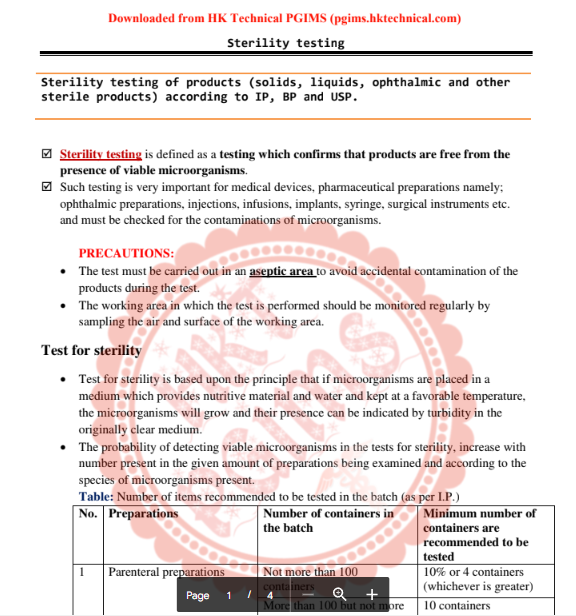Sterility testing of products Pharmaceutical Microbiology Theory (BP303T) Download Notes PDF BPharmacy 3rd Semester 2022
📑 BP303T Pharmaceutical Microbiology
| Title: |
Sterility testing of products Pharmaceutical Microbiology Theory (BP303T) |
| Course: | BPharmacy |
| Semester/Year: | 3rd Semester |
| Subject: | BP303T Pharmaceutical Microbiology |
| Session: | 2022 |
| Category: | Notes |
| Abdi Ahmed Ebrahim BPharm 3rd Semester BPharmacy Microbiology Pharmaceutical Microbiology Handwritten Notes Important Exam Notes | |
You can download BPharmacy Notes & Previous Year's Question Paper from here. All semester-wise Notes & Previous Year Question Papers are available on HK Technical. You can download all question papers & notes for BPharmacy all semester/years for free.You can view All Question Papers From Here.

👉 Download All Question Papers for BPharmacy
👉 Premium Question Paper/Notes Library
Sterility testing
1
Sterility testing of products (solids, liquids, ophthalmic and other
sterile products) according to IP, BP and USP.
Sterility testing is defined as a testing which confirms that products are free from the
presence of viable microorganisms.
Such testing is very important for medical devices, pharmaceutical preparations namely;
ophthalmic preparations, injections, infusions, implants, syringe, surgical instruments etc.
and must be checked for the contaminations of microorganisms.
PRECAUTIONS:
The test must be carried out in an aseptic area to avoid accidental contamination of the
products during the test.
The working area in which the test is performed should be monitored regularly by
sampling the air and surface of the working area.
Test for sterility
Test for sterility is based upon the principle that if microorganisms are placed in a
medium which provides nutritive material and water and kept at a favorable temperature,
the microorganisms will grow and their presence can be indicated by turbidity in the
originally clear medium.
The probability of detecting viable microorganisms in the tests for sterility, increase with
number present in the given amount of preparations being examined and according to the
species of microorganisms present.
Table: Number of items recommended to be tested in the batch (as per I.P.)
No. Preparations Number of containers in
the batch
Minimum number of
containers are
recommended to be
tested
1 Parenteral preparations Not more than 100
containers
10% or 4 containers
(whichever is greater)
More than 100 but not more
than 500 containers
10 containers
More than 500 containers 2% or 20 containers
(whichever is less)
For Large-volume parenteral 2% or 10 containers
(whichever is less or
specified)
2 Ophthalmic and other non-
parenteral preparations
Not more than 200
containers
5% or 2 containers
(whichever is greater)
Downloaded from HK Technical PGIMS (pgims.hktechnical.com)
Sterility testing
2
More than 200 containers 10 containers
3 Surgical dressing and
devices
Catgut, surgical sutures and
other sterile medical devices
for use
2% or 5 packages
(whichever is greater,
maximum 20 packages)
Not more than 100 packages 10% or 4 packages
(whichever greater)
More than 100 but not more
than 500 packages
10 packages
More than 500 packages 2% or 20 packages
(whichever is less)
4 Bulk solids Upto 4 containers Each container
More than 4 but not more
than 50 containers
20% or 4 containers
(whichever is greater)
More than 50 containers 2% or 10 containers
(whichever is greater)
Culture media used for tests of sterility:
1. Fluid Thioglycollate Medium (FTM): is primarily intended for the culture of
anaerobic bacteria; however it also detects aerobic bacteria.
FTM is used for sterility testing by membrane filtration or direct inoculation.
2. Alternative Thioglycollate Medium (ATM): it is used with turbid or viscid products
and for devices having tubes with small Lumina.
ATM is incubated in such way that, to assure anaerobic conditions.
3. Soyabean Casein Digest Medium (SCDM): is suitable for the culturing of both
fungi and aerobic bacteria.
SCDM is recommended for sterility testing of molds and lower bacteria.
Suitability of media
The media used for sterility test should comply the following tests:
i. Sterility of media: Incubate portions of the fluid thioglycollate medium/ alternate
thioglycollate medium at 30-35 and soyabean casein digest medium at 20-25 for not
less than 14 days and observe the presence of the growth of microorganisms in a
sterile media.
ii. Growth promotion test: To each autoclaved load of media for its growth promoting
qualities by separately inoculating test containers of each medium with about 100
viable microorganisms of each of the strains.
iii. Test for bacteriostasis and fungistasis
Downloaded from HK Technical PGIMS (pgims.hktechnical.com)
Sterility testing
3
Methods of sterility test
1. Method A: Membrane filtration
This method is to be preferred where substances examined is:
a) Oil
b) Ointment that can be put into a solution
c) Non-bacteriostatic solid not readily soluble in the culture medium
d) Soluble powder or liquid that possesses inherent bacteriostatic and fungistatic
properties.
For liquid products where volume in the container is 100 ml or more, only method A
should be employed.
This method needs good skill and special knowledge and calls for routine use of positive
and negative controls.
2. Method B: Direct inoculation
📝 BP303T Pharmaceutical Microbiology
📝 BPharmacy 3rd Semester Notes
📝 Download Previous Year's Question Papers
📝 Download Notes PDF
📝 Download Handwritten Notes
📝 Download BPharmacy Question Papers
📝 Download B.Sc. Nursing Question Papers
📝 Download Last Year's Question Papers
📝 BPharmacy All Semester PDF Download
📝 Download PDF Notes as per Latest PCI Syllabus Pattern
📝 Download B.Sc. Nursing Notes as per latest syllabus pattern
📝 Download All Previous Years Question Papers
📝 PGIMS Rohtak Question Papers
📝 AIIMS Question Papers
📝 B.Sc. Nursing Question Papers
📝 B.Tech Question Papers
📝 Download Free PDF Notes



Post a Comment
0 Comments